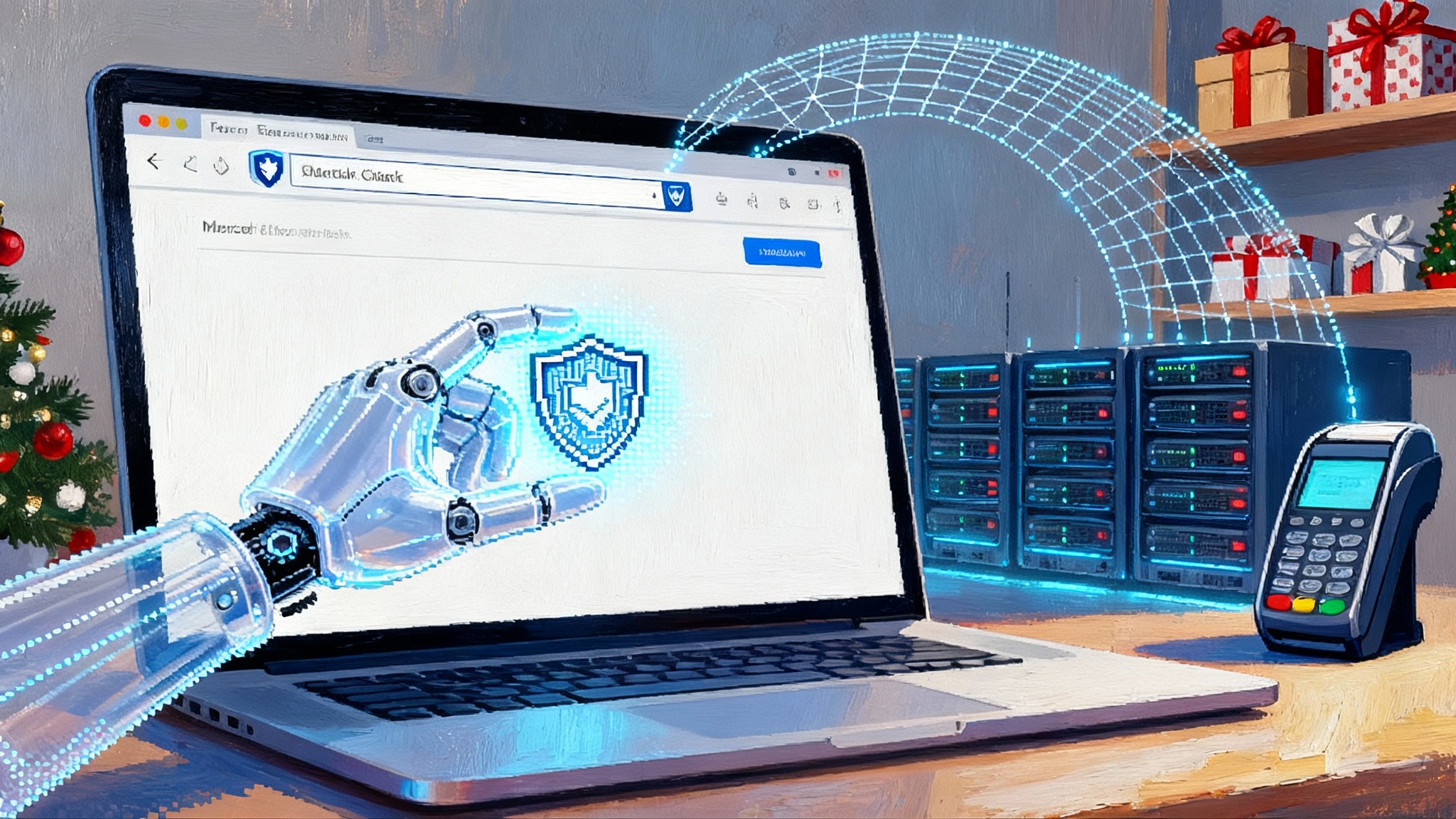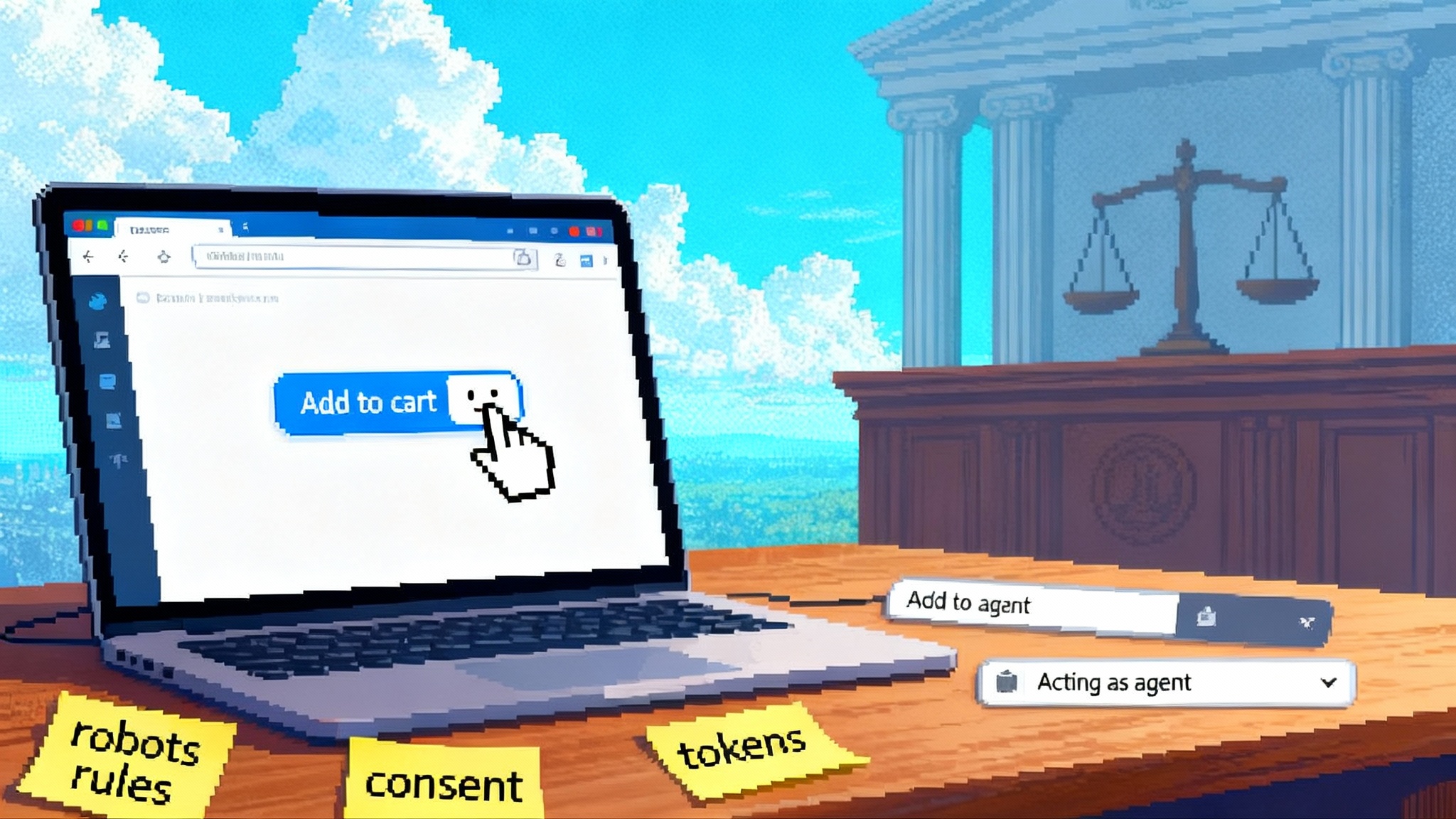Visa’s Trusted Agent Protocol Lights Up AI Checkout
Visa’s new Trusted Agent Protocol adds a cryptographically signed handshake that lets merchants recognize and transact with bona fide AI shopping agents. Backed by major processors, it sets up end to end checkout in 2026.

Breaking: the trust switch for AI shoppers just flipped
On October 14, 2025, Visa introduced the Trusted Agent Protocol, a cryptographic handshake that lets merchants recognize, trust, and transact with bona fide AI shopping agents. Visa says TAP is available to developers now and was built with Cloudflare, with feedback from major processors and platforms including Adyen, Stripe, Worldpay, Shopify, Fiserv, CyberSource, Elavon, Nuvei, Microsoft, Coinbase, Checkout.com, and Ant International. The core idea is simple to state and hard to do at scale: when an agent shows up at a store, the store should know it is an approved agent acting for a real customer, not a bot scraping or probing. Visa’s release sets that standard and ships the first toolkit to make it work across the open web. For full scope and technical anchors like HTTP Message Signatures and Web Bot Auth, see the official press release, Visa unveils Trusted Agent Protocol.
If the last two years were about teaching agents to browse, summarize, and fill carts, 2026 is shaping up to be the year they can check out end to end. TAP is the missing handshake at the front door and the checkout counter.
What exactly launched
Trusted Agent Protocol is an interoperability specification and set of implementation artifacts that enable a cryptographically signed exchange between an AI agent and a merchant site during key moments of a shopping journey. The specification defines standard fields and validation steps that let the merchant’s edge and checkout stack do three jobs in real time:
- Verify that the requester is a trusted agent, not a generic bot.
- Understand the agent’s current intent, such as product detail lookup or purchase.
- Carry optional consumer recognition and payment metadata to streamline checkout.
The protocol sits on web primitives that merchants already use. TAP messages are signed using key material that can be audited and revoked. The merchant, or more commonly the content delivery network or gateway that sits in front of the merchant, validates the signature, checks allowlists and risk rules, then forwards intent and customer signals into existing bot management and checkout flows. Because it relies on web standards instead of custom JavaScript shims, TAP works with modern web stacks without breaking content security policies or accessibility.
How the handshake works, in plain language
Think of an AI agent approaching a storefront. Before it asks for anything sensitive, it presents a digital badge signed by its issuer. That badge states what the agent is trying to do, who vouches for it, and what it knows about the customer it represents. The store’s bouncer reads the badge, calls the issuer to confirm it is valid, and checks its own list of who is allowed in. If everything checks out, the bouncer waves the agent through and tells the clerks which counter to send it to. The clerks then decide if they should fetch the item, apply a loyalty discount, or route the shopper to a faster checkout.
Concretely, TAP builds on HTTP Message Signatures, which means the handshake uses signed headers that standard web infrastructure can parse and verify. The spec defines three core payload types:
- Agent intent. A compact statement such as view product detail or initiate purchase, which helps bot defenses allow commerce traffic while keeping scrapers out.
- Consumer recognition. Signals that a merchant can use to match the agent’s session to a known account or past guest checkout. This is about recognition, not exposure, so it lets the merchant acknowledge a returning customer without leaking credentials.
- Payment information. Optional hints such as supported networks or a token reference that lets the merchant choose the most efficient tender without breaking the customer’s preferences.
Because the data is signed at the source and validated at the edge, TAP gives merchants confidence to let agent traffic through intentionally, rather than relying on brittle user agent strings or ad hoc allowlists.
Built with the edge in mind
Visa developed TAP with Cloudflare. The practical reason is that the edge is where bot management, web application firewalls, and performance tuning already live. If you can verify the agent at the edge, you avoid sending good traffic through gauntlets tuned for bad actors. Cloudflare’s parallel announcement shows how TAP can ride on its Web Bot Auth machinery while coordinating with other networks and card brands, which helps prevent the ecosystem from splintering by issuer, card scheme, or gateway. For the industry view, see Cloudflare’s overview, Cloudflare collaborates to enable agentic commerce.
Why this is the interoperability moment
For the last year, two threads have developed in parallel. On the agent side, the Model Context Protocol, or MCP, has given builders a standard way to plug agents into catalogs, calendars, and logistics systems. On the payment side, networks and gateways have been exploring how to let an agent say who it is, what it wants to do, and how to pay, in a form that security teams trust.
TAP ties the second thread together across a wide coalition. Together with MCP, it creates a clean split of concerns. MCP connects agents to merchant data and actions. TAP makes sure that the merchant’s defenses and checkout are ready to honor those actions from a trusted party. When those two layers work in tandem, autonomous checkout stops being a demo and starts being a deployable path.
If you have followed the broader agent landscape, you can see how this stacks with recent milestones. Vertex’s latest capabilities mean agents increasingly execute real tasks inside enterprise systems. See how Agent Engine unlocks code execution and why that matters for production workflows. On the data plane, Cortex Agents make warehouses runtimes, turning analytics backends into places agents can act, not just query. At the edge, new browsing stacks are arriving, and browser-native agents surge shows how the client itself is becoming agent aware. TAP gives these trends a common trust envelope so they can converge in real commerce.
What changes for merchants
Short term, you do not need to rip out your checkout or customer account system. TAP is designed to slot into the tools you already run.
- At the edge. Update bot management policies to check for TAP signatures and intents. In evaluation mode, you can log and analyze agent traffic without granting special treatment. In enforce mode, you can fast lane trusted agents into product pages and cart endpoints that you may previously have throttled for bots.
- In the customer layer. Use the consumer recognition signal to look up existing accounts or past guest orders. This preserves loyalty, personalization, and customer service when an agent is the browser.
- In payment orchestration. TAP’s payment hints let your gateway or processor route to the most efficient tender while honoring user preferences. Over time, this can pull agent transactions into your tokenized, stored credential flows.
- In analytics and fraud operations. Label requests that pass TAP verification. Measure conversion uplift and false positive reductions in bot defenses. Feed those results back to risk teams as evidence to expand allowlists.
A practical rollout plan
Here is a simple timeline you can adapt based on your risk posture and engineering bandwidth.
-
Next 30 days. Ask your content delivery network or bot management provider for TAP evaluation support. Turn on signature logging and build a dashboard that shows where agent intent arrives in your funnel. Identify the top 20 endpoints that agents hit and confirm that your current rules are not breaking the journey.
-
Q4 2025 pilots. Select one or two flows where agents add value, such as replenishment or travel rebooking. Allow recognized agents to prefill carts, surface loyalty prices, and direct to guest checkout. Measure cart completion rate and time to purchase.
-
Early 2026. Expand to account based checkout with stored credentials. Use TAP to bind the agent session to a known customer and allow step up authentication only when risk flags appear. This is the moment when autonomous checkout becomes viable for returning shoppers.
What changes for agent builders
TAP is not a payments API on its own. It is the trust envelope that lets your agent be treated as a legitimate actor by the merchant.
- Identity and keys. Register as an approved agent with an issuer of keys recognized by the ecosystem. Implement signing for HTTP Message Signatures. Automate key rotation and set up revocation hooks. Treat your agent’s signing keys like a production payment key.
- Intent discipline. Populate intent fields precisely. Overly broad intents will get throttled. Clear verbs that match the merchant’s action model will flow through. Build small, auditable intent vocabularies that security teams and merchants can approve.
- Consumer consent. Design explicit consent moments for account linking, loyalty sharing, and stored credentials. Your agent should carry proof that the customer allowed it to act, not just a convenient assumption.
- Payment routing. Use TAP’s payment hinting to advertise the tender types your agent can present. In the near term, your agent will often hand off to the merchant’s checkout, but the hint lets orchestration select a low friction path.
- MCP alignment. Use MCP to integrate product search, inventory, and customer account actions. Use TAP to legitimize your agent at the network edge and at checkout. Build both and test them together in merchant sandboxes.
- Quality and fallbacks. When an agent is not recognized or risk flags fire, fall back to human confirmation gracefully. Make the handoff obvious and reversible.
Holiday pilots and the adoption curve
Expect conservative pilots through the 2025 holiday season. Most retailers will start in evaluation mode, then selectively allow trusted agents into read and prefill actions where the risk is low and the payoff is immediate. Shoppers will still confirm the purchase in many flows. The measurable wins will be lower false positives in bot defenses, faster page loads for agent driven sessions, and higher completion rates for replenishment or routine purchases.
In 2026, adoption should follow the familiar S curve we saw with tokenization and device wallets. The first wave will be large merchants with sophisticated bot defenses, high repeat purchase rates, and in house payment orchestration. The second wave will be mid market merchants that rely on gateways and platforms which package TAP into plugins. By late 2026, it is reasonable to expect that many top sites will quietly recognize trusted agents, route them through the correct funnels, and allow true end to end checkout for returning customers where risk signals are green.
Three leading indicators will tell you the curve is steepening:
- Processors ship TAP features as defaults. When your gateway checkbox reads Allow Trusted Agents and it is on by default, the curve inflects.
- Agents pass loyalty and fulfillment preferences reliably. That tightens the loop from intent to paid order without human intervention.
- Fraud teams publish comfort thresholds. When policies say allow agent purchase under N dollars with known token and no risk flags, autonomous checkout is no longer controversial.
The new risk and standards landscape
TAP arrives with a clear point of view on standards alignment. Visa called out the Internet Engineering Task Force, the OpenID Foundation, and EMVCo. That matters because the past decade taught the industry that closed one offs cannot survive merchant complexity.
Here is how the standards puzzle fits together as TAP rolls out:
- IETF HTTP Message Signatures. This is the envelope for the handshake. It is transport layer independent, proven at scale, and straightforward to validate at the edge.
- Web Bot Auth. This is a pattern that lets automated clients authenticate themselves to web servers. TAP aligns with it so merchants can keep one bot policy that works for agents too.
- OpenID style identity. Agents need a portable way to prove who they are and who they represent. Expect the OpenID community to shape how agent credentials, consent, and audience restrictions are expressed.
- EMVCo rails. Once an agent is recognized, the transaction still runs on well understood payment rules. That is how tokens, network tokens, and stored credentials flow safely.
- Coordination with other emerging protocols. Visa has said TAP will complement efforts like the Agentic Commerce Protocol and Coinbase’s x402. The ecosystem benefits if these protocols compose rather than compete.
Operational risks are real, but tractable if you are specific:
- Key theft. Mitigation is hardware backed storage, short lived keys, and revocation lists that propagate quickly to the edge.
- Replay and spoofing. Use nonces and timestamps in the signed message plus strict path binding.
- Consent drift. Agents should carry time bounded consent artifacts and merchants should log and surface them in account settings.
- Abuse of merchant rate limits. Apply intent based throttling at the edge, with different ceilings for read versus purchase actions.
Why this unlocks end to end checkout in 2026
Autonomous checkout cannot happen until three things are true at once. Merchants must be willing to let an automated client move through the funnel without being mistaken for a bot. Customers must be comfortable letting an agent operate on their behalf inside known accounts. Processors must route payment with strong assurances that the entity at the keyboard is authorized.
TAP addresses the first and third directly and creates a predictable bridge for the second through consumer recognition and consent signals. Pair that with MCP and modern responses application programming interfaces that let agents fetch inventory, confirm delivery windows, and reconcile loyalty. Suddenly the last unsolved link is not a hard technical problem. It is disciplined consent design and careful business rules. That is why 2026 looks like the first year you will see autonomous checkout in production for replenishment and repeat purchases across major categories.
What to do now
For merchants:
- Ask your platform or content delivery network for TAP evaluation mode and log agent intent today. Track a simple metric: percent of sessions that arrive with valid TAP signatures.
- Get an implementation plan from your processor. If you use Adyen, Stripe, Worldpay, or CyberSource, ask for their TAP and Web Bot Auth roadmap. Map your checkout flows to the fields in the spec so you know where recognition and payment hints will plug in.
- Define a narrow pilot that can measure itself. Replenishment, subscriptions, or travel change flows are good candidates.
- Train your fraud and customer support teams on what trusted agent means, what data is available, and how to revoke access if something goes wrong.
For agent builders:
- Implement signing and verification test suites against TAP sample servers. Automate key rotation and alert on signature failures.
- Build a consent kit that is transparent and revocable. Show the shopper which merchants are linked, what data is shared, and how to pause the agent.
- Align your MCP integrations with TAP intents. The more your verbs match merchant actions, the less friction you will hit at the edge.
- Prepare for fallbacks. When an agent is not recognized or risk flags fire, prompt for human confirmation and make the recovery path clear.
The bottom line
This launch is not a marketing claim. It is code, keys, and a path to production. Trusted Agent Protocol gives the web a common way to tell a helpful agent from harmful automation, and it does it with the primitives merchants already use. Pair it with MCP and the processor ecosystem, and you have the missing link between smart search and true purchase. The most important work for the next year is not inventing new standards. It is adopting the ones that now exist, measuring the lift, and expanding the allowlists. If you do that, by the 2026 holiday season, your best customers will complete repeat purchases while they sleep, and your team will wake up to clean order logs and fewer false positives.








